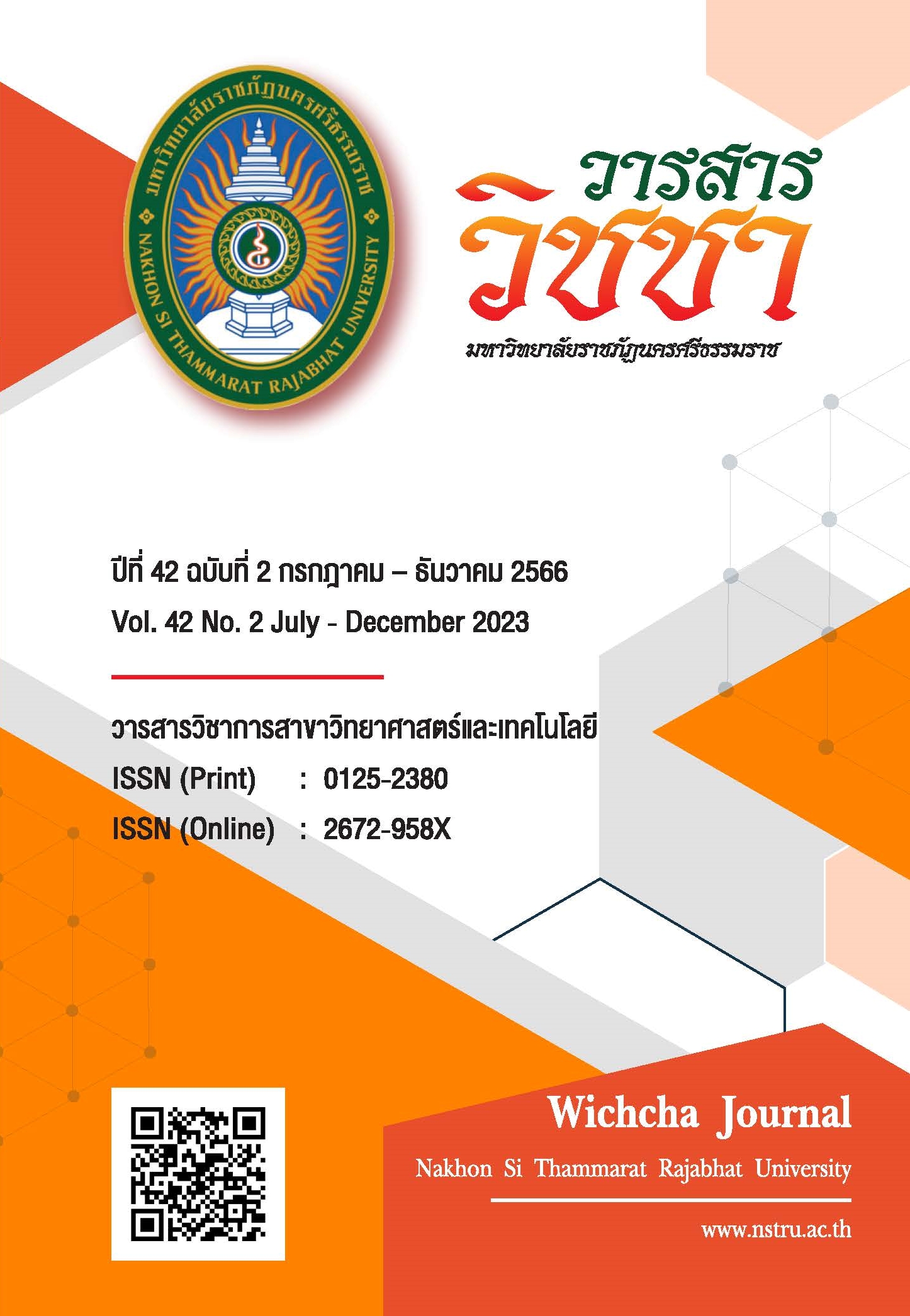The Study of Compression Process and Mechanical Properties of Food Containers from Coconut Shell Fiber
Main Article Content
Abstract
The objectives of this research were to study the production of the food package made of coconut husk fiber and properties of the food package made of coconut husk fiber. Factors in the study were hot compression molding with two levels of temperature, 150 and 170 degrees Celsius and three levels of time required in the hot compression molding process, namely, 4, 6, and 8 minutes at 1,000-2,000 pound-force per square inch. Mechanical properties were measured, which included the maximum average compressive strength of the top view, the maximum average compressive strength of the side view, the maximum average tensile strength, and water absorption. The test results indicated that the maximum average compressive strength of the top view and side view was 1.90 and 2.58 mega Pascal (MPa) at 150 degrees Celsius. The time required for the hot compression molding was 8 minutes, and the maximum tensile strength of the was 2.48 MPa at 150 degrees Celsius. The time required for the hot compression molding was 8 minutes, and water absorption was 14 minutes 60 seconds at 170 degrees Celsius. The time required for the hot compression molding was 8 minutes. Therefore, the appropriate status for the hot compression molding process of the food package made of coconut husk fiber was 150 degrees Celsius for 8 minutes as the package had an overall smooth texture and was strong. Its natural color can be maintained with good mechanical properties. According to the survey on satisfaction with the food package made of coconut husk fiber, it was found that the mean satisfaction score was 3.19, at a moderate level.
Article Details

This work is licensed under a Creative Commons Attribution-NonCommercial-NoDerivatives 4.0 International License.
เนื้อหาและข้อมูลในบทความที่ลงตีพิมพ์ในวารสารวิชชา มหาวิทยาลัยราชภัฏนครศรีธรรมราช ถือเป็นข้อคิดเห็นและความรับผิดชอบของผู้เขียนบทความโดยตรง ซึ่งกองบรรณาธิการวารสารไม่จำเป็นต้องเห็นด้วยหรือร่วมรับผิดชอบใด ๆ
บทความ ข้อมูล เนื้อหา รูปภาพ ฯลฯ ที่ได้รับการตีพิมพ์ในวารสารวิชชา มหาวิทยาลัยราชภัฏนครศรีธรรมราช ถือเป็นลิขสิทธ์ของวารสารวิชชา มหาวิทยาลัยราชภัฏนครศรีธรรมราช หากบุคคลหรือหน่วยงานใดต้องการนำข้อมูลทั้งหมดหรือส่วนหนึ่งส่วนใดไปเผยแพร่ต่อหรือเพื่อการกระทำการใด ๆ จะต้องได้รับอนุญาตเป็นลายลักษณ์อักษรจากวารสารวิชชา มหาวิทยาลัยราชภัฏนครศรีธรรมราชก่อนเท่านั้น
The content and information in the article published in Wichcha journal Nakhon Si Thammarat Rajabhat University, It is the opinion and responsibility of the author of the article. The editorial journals do not need to agree. Or share any responsibility.
References
กิตติศักดิ์ เมืองกลาง ณัฐพงษ์ รักด่านกลา ณัฐวุฒิ ดงกระโทก ทักษ์ดนัย จันทีนอก และธรรณธร ชิดการ. (2564). เครื่องขึ้นรูปภาชนะจากวัสดุธรรมชาติ. วารสารวิชาการเทคโนโลยีอุตสาหกรรม, 6(2), 65-76.
จุฑาทิพย์ อาจชมภู สุวัฒน์ รัตนพันธ์ ฉัตรชัย แก้วดี และวีระยุทธ สุดสมบูรณ์. (2563). สภาวะที่เหมาะสมสำหรับการผลิตไม้เทียมโดยกระบวนการอัดขึ้นรูป. วารสารวิชชา มหาวิทยาลัยราชภัฏนครศรีธรรมราช, 39(1), 84-98.
บุษบา สร้อยระย้า ชมภูนุช เผื่อนพิภพ ดวงกมล ตั้งสถิตพร อัชชา ศิริพันธุ์ และประพาฬภรณ์ ธีรมงคล. (2554). การพัฒนาบรรจุภัณฑ์เพื่อสิ่งแวดล้อมจากเส้นใยกล้วยสำหรับบรรจุผลิตภัณฑ์อาหารสำเร็จรูป. รายงานวิจัย. มหาวิทยาลัยเทคโนโลยีราชมงคลพระนคร.
ปัตติยา ช่ออังชัน ชุตินันท์ คชสีห์ กัญญารัตน์ คงมั่น และธิดารัตน์ พรหมมา. (2565). ศึกษาคุณสมบัติของภาชนะที่ผลิตจากเส้นใยหญ้าขจรจบและเส้นใยผักตบชวา. การประชุมวิชาการระดับชาติสำหรับนักศึกษา มหาวิทยาลัยราชภัฏกาแพงเพชร ครั้งที่ 2. กำแพงเพชร.
ลดามาศ เบ็ญชา ณัฐวดี ช่อเจริญ ญาณสินี สุมา และนิตย์ตะยา ผาสุกพันธุ์. (2559). ความเป็นไปได้เบื้องต้นในการผลิตบรรจุภัณฑ์ที่เป็นมิตรต่อสิ่งแวดล้อมจากเศษวัสดุเหลือทิ้งทางการเกษตรในพื้นที่จังหวัดเชียงราย. การประชุมวิชาการระดับชาติ “นเรศวรวิจัย ครั้งที่ 12 : วิจัยและนวัตกรรมกับการพัฒนาประเทศ”. พิษณุโลก.
วรพงค์ บุญช่วยแทน และชาตรี หอมเขียว. (2565). ส่วนผสมและกรรมวิธีการผลิตบรรจุภัณฑ์จากเส้นใยเปลือกมะพร้าว. อนุสิทธิบัตรไทย เลขที่ 2203001405. กรุงเทพฯ: กรมทรัพย์สินทางปัญญา กระทรวงพานิชย์.
วรรธนพร ชีววุฒิพงศ์ ชาตรี หอมเขียว และสุรสิทธิ์ ระวังวงศ์. (2565). การศึกษาเชิงเปรียบเทียบผลกระทบของปริมาณและชนิดเส้นใยปาล์มน้ำมันต่อสมบัติของวัสดุเชิงประกอบพอลิโพรพิลีนและขี้เลื่อยไม้ยางพารา. วารสารวิจัย มหาวิทยาลัยเทคโนโลยีราชมงคลศรีวิชัย, 14(1), 31-46.
ศศิกานต์ สุวรรณประทีป อดุลย์ หาญวังม่วง และสมพงษ์ พิริยายนต์. (2562). การผลิตโฟมบรรจุภัณฑ์จากแป้งข้าวเจ้าผสมด้วยเส้นใยเซลลูโลสจากผักตบชวา. รายงานวิจัย. มหาวิทยาลัยเทคโนโลยีราชมงคลสุวรรณภูมิ.
ศิริพร เต็งรัง ประยูร เอ็นมาก ภัสสร เลียบวัน มงคล ตุ่นเฮ้า คุรุวรรณ์ ภามาตย์ พุทธินันท์ จารุวัฒน์ นกศักดิ์ ลอยเลิศ สุปรียา ศุขเกษม วิมลวรรณ วัฒนวิจิตร โกเมศ สัตยาวุธ ศุภมาศ กลิ่นขจร จารุวรรณ์ รัตนสกุลธรรม สาเริง ช่างประเสริฐ รังสิทธิ์ ศิริมาลา และมานพ คันธามารัตน์. (2558). วิจัยและพัฒนาบรรจุภัณฑ์. รายงานวิจัย. กรมวิชาการเกษตร.
ศูนย์เทคโนโลยีสารสนเทศและการสื่อสาร สำนักงานปลัดกระทรวงพาณิชย์. (2564). ปลูกมะพร้าว. สืบค้นเมื่อ 15 กรกฎาคม 2565, จาก: https://tradereport.moc.go.th/TradeThai.aspx.
สิปราง เจริญผล นวลนภา จุลสุทธิ และรัชนิกร กุสลานนท์. (2564). การใช้กระบวนการอัดร้อนใบข้าวโพดเพื่อใช้เป็นวัสดุทดแทน สำหรับการออกแบบและพัฒนาผลิตภัณฑ์. วารสารสังคมศาสตร์วิชาการ, 14(1), 113-124.
Global Trade Atlas (GTA). (2564). มูลค่าส่งออก. สืบค้นเมื่อ 15 กรกฎาคม 2565, จาก: https://ihsmarkit.com/products/maritime-global-trade-atlas.html.
Mohanty, S., Verma, S.K. and Nayak, S.K. (2006). Dynamic mechanical and thermal properties of MAPE treated jute/HDPE composites. Composites Science and Technology, 66(3-4), 538-547, doi: https://doi.org/10.1016/j.compscitech.2005.06.014.


